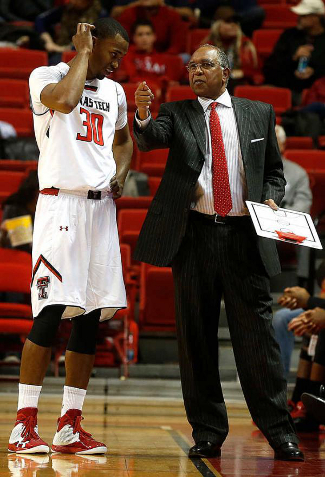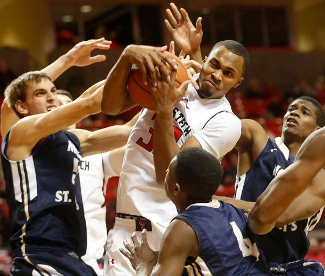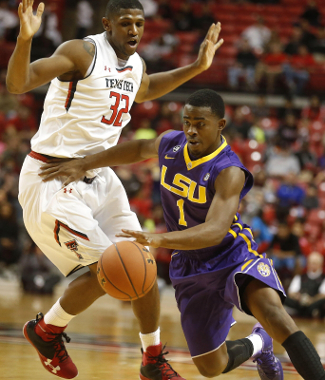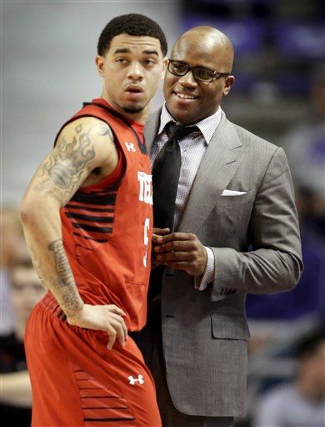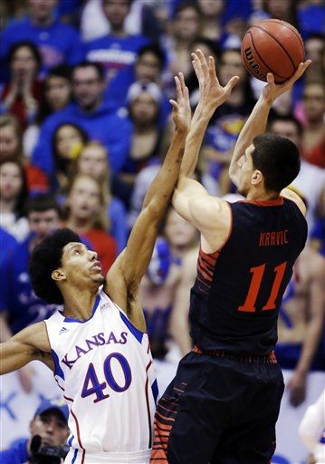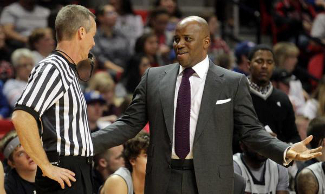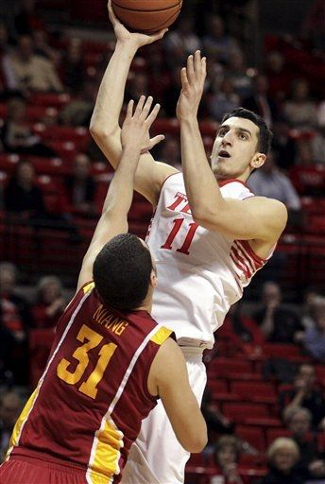United Supermarkets Arena | Lubbock, TX | Tip: 1 P.M. CT | TV: ESPNU Vegas: Texas -8 | KenPom: Texas, 64-57 (80%) The most anticipated Big 12 season in years is just hours away, and the Texas Longhorns open things up in Lubbock this afternoon. From top to bottom, the Big 12 is the deepest league in the country, currently boasting the nation’s top RPI, while also earning the top conference rating from Ken Pomeroy, by a wide margin. Pomeroy’s conference ranking takes into account the offensive and defensive efficiencies of every team in the leauge. To put the first seven weeks of the Big 12’s dominance into perspective, the ACC — which currently is ranked second — is closer to the fifth-ranked SEC than they are to first, and are nearly as close to the Pac-12 in sixth. There’s the Big 12, a big gulf, and then everyone else. With such a deep league, the names of numerous Big 12 contenders have littered the pages and websites of the college basketball media. While a few pundits have dared to pick Texas, most have stuck with Kansas. And why not? Over the last ten years, the Jayhawks have taken advantage of a nearly automatic home-court advantage, great coaching, and great talent to win at least a share of the league crown every single year. To take the title this year, Texas, Kansas, and the laundry list of contenders will have to survive a meat-grinder schedule. Eight of the league’s ten teams are in the Top 50 of Pomeroy’s rankings, while K-State sits just outside the Top 100, and even Texas Tech is ranked 141st. The usual formula for a conference title — defend your home court, sweep the bottom of the league, and pick off a tough road win or two — might not even be possible this season. The “bottom of the league” consists of just two teams, which both have great home courts and a roster of talented parts that haven’t yet put it together. For the Longhorns, their difficult task became a little easier when they received some much anticipated good news yesterday morning. After breaking a bone in his wrist in the third game of the year, point guard Isaiah Taylor is back for Texas, just in time to lead his team into the melee of the Big 12 conference race. For a Longhorn team that has posted abysmal turnover numbers the last few weeks, his return comes as a huge relief. While Taylor can’t make every pass and eliminate all of the team’s miscues, it’s hard to imagine that things won’t get at least a little better with him at the helm, and other players back in their natural roles. Texas may also get a bit of a boost this afternoon from Mother Nature. Even though it’s been nearly a decade since United Supermarket Arena was consistently full for conference games, numerous Big 12 teams have fallen victim to upsets on the High Plains over the years. With winter storms blanketing the Texas Panhandle last night and this morning, the USA will likely be very empty. As long as Texas doesn’t fall into the lull that sometimes accompanies early-afternoon games and sparsely-attended contests, they should find it a little easier to survive the annual Lubbock trip. By the Numbers In Year Two of the Tubby Smith era at Texas Tech, you can see that the pieces are beginning to fall into place. Smith landed the best recruiting class that the Red Raiders had seen in 11 years, which gives them the kind of athletes that can compete in a major power conference. Those athletes are still learning to compete at this level, as evidenced by their poor offensive efficiency and struggles against zone defenses. The Red Raiders are scoring jut 97.6 adjusted points per 100 possessions, which currently ranks 227th out of 351 Division I teams. Thanks to an ugly 30.5% mark from beyond the arc, opponents are able to play sagging zone defenses and dare Tech to beat them with long jumpers. Another part of the problem is that when the Red Raiders do manage to get it inside, they aren’t able to turn that into points. Tech currently has the nation’s fourth-highest field goal rate, earning a free throw for every 1.86 field goals they try. However, they are leaving a ton of points at the line, converting on just 66.9% of their attempts. Add in a sub-optimal turnover percentage of 20.5%, and it becomes clear that the Red Raiders are still often shooting themselves in the foot on offense. On the other side of the ball, Coach Smith has his team playing much better defense. The year prior to his arrival, the Red Raiders had an adjusted defensive efficiency that was ranked 254th out of the 347 teams in D-I at the time. Last year, they improved to 110th, and are currently sitting at 81st with 95.9 adjusted points allowed per 100 possessions. That number will certainly rise against a Big 12 loaded with efficient offenses, but it’s another sign of the improvement Tubby has brought to Tech. The Red Raiders do a good job pinching from help positions to discourage penetration, and they close out nearly three-quarters of their defensive stops by securing the rebound. For a team that often played matador defense in recent years — an appropriate style, considering their mascot — any progress is worthy of note. Meet the Red Raiders Although Tech lost star Jordan Tolbert and sharpshooter Dusty Hannahs to offseason transfers, a seven-man recruiting class has lessened the impact of those departures. It’s also given Coach Smith a blend of experience and youth, skewing towards the latter, which will set the building blocks for his rebuilding project. Tubby has a very deep bench, and he uses it to the fullest. The Red Raiders have a core rotation of seven players who all average between 20 and 25 minutes, along with three other role players who typically see some action in each game. Tech doesn’t use this depth to play an up-tempo, trapping style, but it does offer Tubby a chance to immediately pull players when he sees a teaching opportunity. The player who sees the most minutes is senior guard Robert Turner (No. 14), who was Tubby’s first recruit as a JUCO transfer two summers ago. Although he runs the point and has the ability to slash to the lane, Tech’s struggles against zone defenses often result in him dribbling the air out of the ball before putting up a challenged or off-balance shot before the 35-second buzzer. Turner has the team’s second-highest percentage of shots taken, as he’s responsible for 26.6% of the attempts when he’s on the court. Unfortunately, he has an effective field-goal percentage of just 43.7%. He does somewhat make up for that lack of production by jumping passing lanes on defense and stripping it from unsuspecting guards to start the break. The highest percentage of shots taken belongs to newcomer Devaugntah Williams (No. 0), a JUCO transfer from Missouri-West Plains. Williams plays about 24 minutes per game and takes more than 30% of the shots when he’s on the court, but is much more effective than Turner. That is a result of good speed with the ball and the ability to quickly change direction while penetrating. Although it was a little more wild than his usual drives, his spin and drive to the rack with two seconds left against Auburn provided the game winner. Williams is also a very streaky shooter from behind the arc, and the team’s struggles in two recent losses in Las Vegas underscore the importance of his long-range game to their success. On the season, Williams has made 37.5% of his three-point attempts, despite going 0-for-14 from long range during that two-game losing streak. Williams also had a stretch earlier in the year where he made 14-of-23 in a five-game stretch, so his accuracy tonight could be the biggest factor in Tech’s output. On the wing, freshman Justin Gray (No. 5) has started 12 of the team’s 13 games. He’s a very long 6’5″ and has great hops that aid him in quickly springing up to block shots. His individual block rate of 4.2% ranks third on the team and 299th in Division I. That bounce also helps to make him a good rebounder from the wing, something that is important for a Tech team which will be a bit undersized against Texas today. Down low, two newcomers anchor the frontcourt for Coach Smith. Zach Smith (No. 11) is a really exciting 6’8″ forward, who was one of the top 20 seniors to come out of the state of Texas last season. He is very quick and slippery with the ball for a guy his size, and he passes very well from all over the court. Smith injured his back on December 19th, played just 14 minutes in a loss to Loyola Chicago three days later, and sat out of the loss to Houston. However, he returned to action on Monday night against North Texas and showed no ill effects of the injury, logging 34 minutes and stuffing the stat sheet. Norense Odiase (No. 32) is the man in the middle, and man is the operative word for this 6’9″, 270-pound freshman. He moves remarkably well for a guy his size, although he does clearly struggle when opponents push the pace for extended stretches. Odiase is very strong with the ball down low, and is a solid rebounder and shot blocker. He’s also the team’s biggest offender when it comes to leaving points at the line, as he draws 5.5 fouls per game, but has made less than 59% of his free throws. Off the bench, Randy Onwuasor (No. 3) is another guard that plays solid perimeter defense and can jump-start Tech with a take-and-make. He’s joined by Toddrick Gotcher (No. 20), a junior guard that can easily create for himself and teammates with the bounce, thanks in large part to a knack for mixing speeds. Rounding out the bench options in the backcourt is freshman Keenan Evans (No. 12), a lightning-quick guard who can easily burst to the rim or drain a three from well beyond the arc. Evans has connected on 41.2% of his threes in his limited minutes, and will likely be an impact player for Tech in future seasons. Down low, most of the minutes are eaten up by the two starters, but Tubby does rotate in a quartet of forwards. Senior Clark Lammert (No. 35) averages less than eight minutes per game, and is best known for taking charges and being the brother of Connor Lammert. Sophomore Alex Foster (No. 34) is used even more sparingly, likely due to his hideous 35.7% turnover rate. Fellow sophomore Aaron Ross (No. 15) should prove to be a solid option down low, but he’s still getting into game shape after seriously injuring his knee in April. He returned to action on December 14th and has averaged less than seven minutes in six appearances. The bulk of the frontcourt reserve minutes go to freshman Isaiah Manderson (No. 1), but he is still only seeing the court for about 11 minutes per game. He’s a long and lean 6’10”, with probably an additional two inches of height coming from his hair. Manderson has a quick release on a midrange jumper that is smooth, albeit inconsistent. At this point, his biggest problem is really poor defense, and that will likely limit his minutes under Coach Smith. Keys to the Game 1. Pack it in – The Longhorns have the size to make things very tough inside for most opponents, and Tech’s inability to shoot from outside means that the Longhorn guards can make things even tougher by sagging off enough to limit penetration. As long as Texas doesn’t let Williams or Evans go off from long range, they should not have much to worry about in terms of threes and long jumpers. 2. Control the basketball – With Taylor finally returning for Texas, this will be the first chance to see if the Longhorns can make a drastic cut in their turnover rate. The Red Raiders have forced mistakes on 22.3% of their defensive possessions, albeit against a relatively weak schedule. Even though Tech’s defense is pretty good, the Longhorns will face much tougher in the coming weeks. Improving ball control is not only important to avoid an embarrassing upset today, but also to contend in the league this season. 3. Clean the glass – Tech has posted solid rebounding numbers on both ends of the court, but they have not faced many teams with the size of Texas. The Red Raiders currently boast rebounding marks of 36.8% and 72.1% on the offensive and defensive ends, respectively, despite playing most of their minutes with forwards that are 6’8″ and 6’9″. Against LSU, a team with an effective height that’s 28th in the nation according to Pomeroy, the Red Raiders managed an offensive rebounding rate of just 25% in an overtime loss. The Longhorns should present a similar challenge for Tech tonight, and they must exploit that advantage to prevent Tech from hanging around and being in position to steal an upset in the final minutes. |








